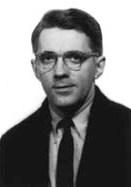David Tudor
| David Tudor | |
|---|---|

Tudor circa 1950
|
|
| Background information | |
| Born |
January 20, 1926 Philadelphia, Pennsylvania, U.S. |
| Died | August 13, 1996 (aged 70) Tomkins Cove, New York, U.S. |
| Occupation(s) | musician, composer |
| Instruments | Piano |
| Associated acts | John Cage, Merce Cunningham |
David Eugene Tudor (January 20, 1926 – August 13, 1996) was an American pianist and composer of experimental music.
Tudor was born in Philadelphia, Pennsylvania. He studied piano with Irma Wolpe and composition with Stefan Wolpe and became known as one of the leading performers of avant garde piano music. He gave the first American performance of the Piano Sonata No. 2 by Pierre Boulez in 1950, and a European tour in 1954 greatly enhanced his reputation. dedicated his Klavierstück VI (1955) to Tudor. Tudor also gave early performances of works by Morton Feldman, Earle Brown, Christian Wolff and La Monte Young.
The composer with whom Tudor is particularly associated is John Cage; he gave the premiere of Cage's Music of Changes, Concert For Piano and Orchestra and the notorious 4' 33". Cage said that many of his pieces were written either specifically for Tudor to perform or with him in mind, once stating "what you had to do was to make a situation that would interest him. That was the role he played.” The two worked closely together on many of Cage's pieces, both works for piano and electronic pieces, including for the Smithsonian Folkways album: Indeterminacy: New Aspect of Form in Instrumental and Electronic Music (1959). Tudor also performs on several recordings of Cage's music, including the Mainstream record of Cartridge Music, the recording on Columbia Records of Variations II, and the two Everest records of Variations IV. Tudor selected the works to be performed for the 25th Anniversary Retrospective Concert of the music of John Cage (May 16, 1958), and performed in the premiere of the Concert For Piano and Orchestra given as the closing work for that concert.
After a stint teaching at Darmstadt from 1956 to 1961, Tudor began to wind up his activities as a pianist to concentrate on composing. He wrote mostly electronic works, many commissioned by Cage's partner, choreographer Merce Cunningham. His homemade musical circuits are considered landmarks in live electronic music and electrical instrument building as a form of composition. One piece, Reunion (1968), written jointly with Lowell Cross features a chess game, where each move triggers a lighting effect or projection. At the premiere, the game was played between John Cage and Marcel Duchamp. Reunion is erroneously attributed to Cage in James Pritchett's book The Music Of John Cage.
...
Wikipedia
